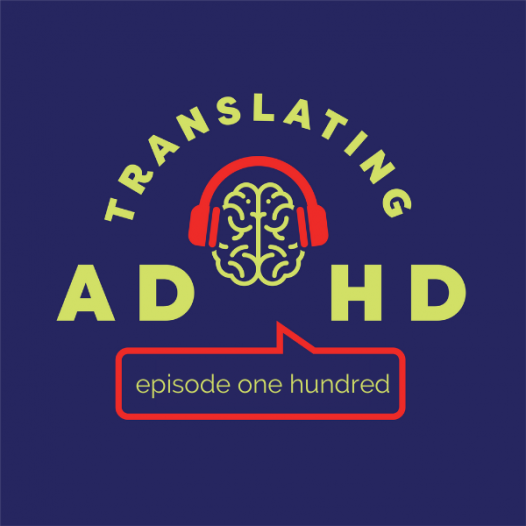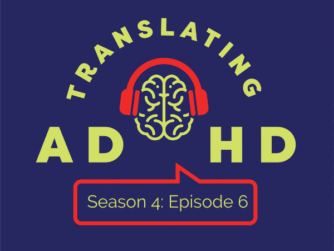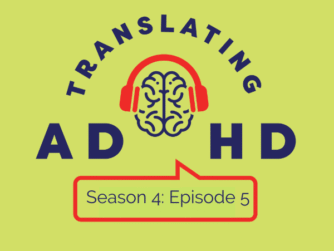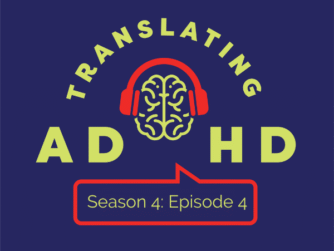Shelly and Cam continue to explore contextual pitfalls and ADHD. Last week they introduced contextual mad-libs. This week they explore two more contextual challenges, ‘locking in’ to a limiting narrative and conversely ‘spinning through’ multiple narratives. Both are contextual in nature and a very ADHD Valley experience. We constantly tether to how we relate to our world, drawing frames of reference that meet a need that may be keeping us in a current state or mode and delay real and positive change.
ADHD is partially an ‘access and regulation’ dilemma; accessing and regulating attention, emotion, memory, energy, motivation and action. Our experience is a ‘Goldilocks’ experience of too little or too much. For example, our emotional experience is often one of too much emotion or not enough emotion. The same goes for creating meaning in our current moment – tethering to our current context. Cam shares two successive periods in his life when he experienced both the lock-in experience and the spinning experience.
For the lock-in, Cam shares how he fueled a ‘One Down’ perspective with a singular limiting story and the energy cost of keeping this ‘roadshow’ going. He then shares how he switched to the spinning version to rationalize a behavior and ‘play it safe’. This ‘channel switching’ is the situational rationalization we’ve discussed before.
Cam and Shelly share practices for listeners to bring the Keen Observer to these unique presentations of contextual pitfalls.
Episode links + resources:
For more of the Translating ADHD podcast:
- Episode Transcripts: visit TranslatingADHD.com and click on the episode
- Follow us on Twitter: @TranslatingADHD
- Visit the Website: TranslatingADHD.com
Episode Transcript:
Shelly: Hi, I’m Shelly.
Cam: And I’m Cam.
Shelly: And this is translating ADHD this week. We’re going to continue pulling on this thread of context and particularly the hurdles and dilemmas that context can create for us as people with ADHD. Before we do that, just a brief note that we are now accepting applications for our next coaching group, which will be on the topic of agency.
This course begins Wednesday, January 19th, and we meet at 8:30 PM Eastern time. For more information, visit the website, translating adhd.com, and click on the group coaching tab. So Cam, where are we headed today as relates to context?
Cam: So Shelly, last week we were talking about contextual Madlibs. Right? You had that great example from yours. Where they got a message from someone and there wasn’t a lot of contexts. There, there wasn’t a lot of backstory or they started to fill in story substitute context where context was missing and going far back into their past challenging work experience. That’s one example of a contextual pitfall, and we want to introduce two more that we see with our clients and I think they’re very unique with ADHD and those two are this locking into a context, We see this in limiting beliefs or limiting perspective. Often when someone drops down into the. It’s the, okay, here we are. Here’s the story. And this is my part in this play that I know. Oh so, well, I know all the characters. I know the props and it’s locked in and then we play this out and it’s not positive. So locking. To a context, the other is cycling through contexts. So first the added piece here is around access and management.
But if you think about the mechanisms at work, it’s about locking into attention, locking into motivation. Or we spin through it, we will cycle and we will flip and not be able to engage. So this is the consistent element here that everyone with ADHD understands, we will get kind of locked in hyper-focus or we spin our wheels.
So same thing with context, we can lock into one and a particular story. Just so informing, it feels like absolute reality.
Shelly: Cam in a way. I see the one-down perspective as the ultimate story that we get locked into as ADHD people. And then those other stories underneath the ones that show up and inform on a regular basis. That’s what keeps us at one down.
And what’s so interesting to me is feedback from clients and from our listeners, people who’ve never heard it talked about this way, this idea of the one-down perspective. And so listeners, when we’re talking about how content.
Limits us and informs us. We’re really getting to the heart of how do we end up in this one-down perspective what’s going on for us?
Cam: Right. So again, we are wired for context, we’re wired for story. And so we will tether to and lock into a story. That reinforces our own experience. And I’m going to give my own example here. The flip side of this is where we are Rolodexing or flipping through contexts around this phenomenon called situational rationalization. Right? Is that if you ever find yourself saying well, it depends. It’s likely that you might be again rotating through stories, trying to find a story that fits your current situation, because it might be that you’re avoiding something uncomfortable, which could be a conversation, Right, or inaction in the sense of getting started, we have that glitchy activator to get into action, to start our taxes, to start this project. And so we will make excuses, but the way we make excuses is we will find a story that fits. Our current way of being, you see these two extremes of we locked into a story or we’re kind of Rolodexing stories and in that situation, it’s really a delay tactic. So let’s start with first of all the blocking in, and I’ll share my own story and also share a couple of other ways that this can show up because there’s one more, right. there’s the one that. But there’s also the magical thinking of, There’s one thing I’m missing. And when I find that I’m going to figure this add thing out, there’s a story there. I just need to find the right tool. I need to find the right system and I’ll be on my way. So a couple of different ways that we can lock-in. A story or a context that may or may not be serving us. So at the end of the session today, at the end of the episode, we’ll talk about what you can do to bring your keen observer and notice context. And is it not necessarily working for you? Oh, by the way, we are going to look at context and how it can be a positive thing.
That’s going to be coming up pretty soon. All right. So back to this one down, I’ve talked a lot about my experience teaching and in that period of feeling the imposter syndrome, not belonging. And so in that experience, when I was stressed and overworked and never a free. What I had in my mind was I don’t belong here and they’re gonna find me out, right. classic imposter syndrome language. So what did I do? I wasn’t, that guy was going and seeking and sampling from others. If this was the truth or not, I started to create. My own drama here, my own three-part play of, yep. I’m looking around me and my context or My story is informing my belief. And then I’m cherry-picking from that context. To reinforce that belief of I don’t belong and they’re going to find me out. So then I don’t belong and they’re going to find me out. What do you think I do then? Shelly?
Shelly: What do you do then? Cam.
Cam: All of my behaviors going forward are in the service of that. Right. It’s informed. And am I going forward with curiosity? Am I bringing my keen observer? In this situation, am I being resilient? No, I am in this really limiting place. And it just heaps on itself that when we have our valley experiences and we’re really down in that valley and our context, we lock into a story that reinforces where we are. It’s so tough to get out of that situation because we will again be selective in the threads or what we’re tethering to, and it’s not necessarily positive. So we’re connecting to these negative things. Our brain is actually Again it’s kind of exciting for the brain part, the brain chemistry part because guess what? We’re attending, I’m attending to this thing. That’s not necessarily based in reality, but I don’t know that. I think it’s the reality. I think I’m going to be found out. So then it’s like, I go to ground, right? I am looking over my shoulder. And that story is reinforcing my experience and it’s a self-fulfilling prophecy.
Shelly: Cam we see this so often in our clients, these repeated or chronic valley experiences, these places where our clients truly believe they can’t have a different experience. The cool thing about coaching is we know the answer. It’s curiosity. If we can get the client to a curious place and get them up above it just a little bit, they can start to see the bigger picture and start to see all of the context rather than this little piece.
And often when I get my clients to that place and they hear those limiting beliefs, it’s funny. My client with the secret whiteboard last week, when he said that in the valley place, I could feel the visceral anxiety and fear behind it. When we got back to it from the curiosity place, belly laughs from both of us, because he was able with all of the context to see the absurdity.
And to appreciate that and to find some humor in it. Cam, I’m curious, in your case, we’ve talked about sort of the chronic valley place you were in. What happened next? Where did you go? How did you get curious?
Cam: Yeah, we talk about The arc response right on the outside is this adrenaline response cycle of responding to crises. So that’s, what’s happening on the outside on the outside. Is this pony and trying to drag that arc pony out every day to go and show up and deliver five lesson plans and do other things there at school and on the inside, talk about this too, is. The rumination, the spinning around this kind of external sampling and internal reinforcing. Right? So again, not seeing myself in the picture, not coming back to that. I am somebody of value was missing that had gotten misplaced in the presence of. Big signal, The big signal. It’s like a bright sun that just blots out any kind of shadow or contrast. And so this external sampling internal reinforcement fueled itself into this circular thinking. What happened though, is that I couldn’t deny the evidence that was actually out there. I wasn’t getting like. I was being asked to serve on committees. I was asked for my expert opinion, I was asked to do certain things and seeing also the people there genuinely wanted me to be there.
And in the midst of my valley experience, the evidence became irrefutable of like, oh, This story isn’t really holding up. I’m kind of, reinforce it or giving it life. But it’s also, costing me. It’s making me play small.
And so that cost-benefit analysis that we often do in coaching. What’s the cost of this limiting belief, this perspective, and what’s the benefit, right? I wasn’t taking risks. I wasn’t putting myself out there. It’s kind of plain small, just staying in the shadow. And so this was the realization and it’s like, you know, I can keep doing this at a tremendous cost Shelly expenditure of energy to carry this caravan, you know, and this sort of roadshow with me everywhere was exhausting.
Shelly: I’m curious to hear what the benefit was. What’s there.
Cam: Well, Again, the benefit was in a sense not taking risk, right? Not putting myself out there, playing it safe. Right. Of there’s a comfort in playing it safe. We talk about change. Change comes with discomfort. And so that little bit of discomfort too, we can step back from. And this is actually connected to the other presentation of context that we can move to.
So a good ending to my story you know, seeing that I was really locking into a story that had me play it safe, but also not move anywhere. Not. Not change. And so that was the real change thereof like, what is it I want coming back to purpose coming back to agency.
And if I’m going to create the change, it’s going to come from me. I have to take the first step. And so the first step was to challenge that story I had locked into and become bed partner.
Shelly: am. I love your articulation of the cost-benefit analysis. That is when we’re going to a valley place with a client it’s such a useful thing to examine. How is this serving you alongside how is it limiting? Because oftentimes when we name a limiting perspective client just wants to blow through it.
I see it. We’ve named it now. How do I shift that perspective and pull a 180, but sometimes there’s really important information in that question of how is serving you for you, it was about risk. Aversion about aversion to change, about being comfortable for my clients that have that on board that aversion to risk or change.
I see that show up often. It’s like this maladaptive protective mechanism because his behaviors didn’t come from nowhere. You were adapting to something. So part of our job in coaching is to distinguish what’s adaptive. What’s serving you, that we can carry forward and build upon and what’s maladaptive.
And so let’s look at the maladaptive behavior and see what it is. You were attempting to adapt to. And how we proceed from there. I imagine for you, there was some work to do around comfort with change and risk.
Cam: Right risk avoid it. Right. member of that whole thing about, you know, you need to be more assertive, right? You need to develop more of that warrior, that red side of you. There’s too much blue. And that whole idea of assertion. What is that? But this is how my ADHD was showing up and I couldn’t see it that when you start to understand. This contextual stuff, you can dig into these root challenges, root causes around activation. I could just avoid and float my way through. And so it’s really fascinating as I’m thinking about this. And we went to Asheville and I went, again, part of that guru thing, but also I remember a mentor and he sat me. For something. still remember Shelly, It’s not quite right. And I made some kind of an excuse to not show up, to do this program with him. Did I ever hear from that guy again? No. He gave me a chance. He did the thing that I asked me to do.
And then I balked in that moment. And that was me going from that entrenched context to this situational rationalization it’s not, that you’re just one or the other, again, it’s like emotion in the sense that we can. Super locked in or have a big and emotional moment or not engage with it at all not feeling emotional about anything, that accessibility piece. So I went from this locked in story to easily this situational rationalization of well, it’s not quite right. I conveniently changed the channel. On the story to protect my mode and my mode was not to take a risk. So it’s a fascinating thing that happens here, both of these types of contextual pitfalls showing up for me in different ways. And so. in that situation, it just, had to do with not belonging, but how easily we can switch the channel, switch the story. Get entrenched in one, versus the situational rationalization. I see it with my clients when the neuro-typical spouse is like, what’s your opinion on.
And my neuro divergent clients wired for context respond with depends. It depends on the current context. And so that can be a super power, but it also, we’ve just got to watch out for it. Are we leaning too hard on it? Are we using that as a tool to avoid engaging And stepping into what might be uncomfortable on the front end, but very rewarding on the backend.
Shelly: So, Cam, what is the practice for our listeners around context and getting locked into a story or this story? Switching this, changing the channel.
Cam: Like anything like any where we start, where do we start listeners? We always start with bringing the keen observer. We always start with curiosity. We always start with giving yourself a break. Right. You have to be careful about beating yourself up for seeing this for maybe the first time or this new awareness.
It’s a new awareness of something that’s always been there. And so giving yourself a break, bringing grace and compassion and curiosity, and start to see. What are the different factors that contribute to each scenario? So not to overload you with too much field work this week, but just to maybe focus on one or the other, the locking into a story or the situational rationalization, pick one of those and just see how it plays out.
And as we talked about before to consider okay. What’s the benefit of me doing this. There’s always a benefit people. There’s always a benefit to any behavior, whether it’s adaptive or maladaptive. Why do people smoke? There’s a benefit. You get a payoff. Is it good for you now? So start with the benefit and really consider the costs.
And as you consider the cost again, bring curiosity and don’t pile on, oh, you’ve wasted all this time. Oh my God. How are we ever going to get out of this story? Naming it? Are you like me where you kind of take this caravan with you? That’s what I noticed. it was a road show that I was taking with me everywhere.
And I started with just the amount of energy. That I was putting into keeping these props and this story alive. It’s a tremendous amount of energy that I could be putting towards something really rewarding, really fulfilling. That was that big idea generator, Shelly, would just line up and put its shoot directly above that story and film. Pop pop, pop, Pop, and it’s stimulating. And my brain is alive and yet my mind is getting taken to the woodshed. So again, breathe, step back and just see where context is coming into play in a, not so positive way. As we said next week, we’re going to talk about context in a positive manner and how you can turn context and how we’re wired that way.
Into a strength into a practice, into a tool.
Shelly: Well said, Cam, if you’re wondering why I’m sitting here snickering, we miss something and he guesses what it is.
Cam: What did we miss? Shelly?
Shelly: If y’all could have seen the confused look on Cam’s face. This is our 100th episode. Yes.
Cam: no way. Oh my God.
Shelly: Wow. Look at that.
Cam:
look at that great way. We celebrated, like here we are doing the work. I love that you picked that up. on that. Yes it is. Yay.
Shelly: Yay
us. Gosh. Remember when this felt like something that was so far away and something that might never happen 100 episodes.
Cam: Yeah. We were thinking 52. We were thinking one year. That’s what we’re thinking.
Shelly: Yeah. And here we are.
Cam: How about that? Here we are.
Congratulations.
Shelly: Yeah, congratulations to you too. And thank you to each and every one of you listening to this episode, it is your following. Your sharing with us, what you’re learning and the work that you’re doing, the incredibly powerful experiences we’re having an individual and group coaching with our clients who also listen to the show and use it as another way to do this work that keeps us coming back week after week.
This work is tremendously tremendously rewarding.
Cam: Yeah. And so seeing your reviews and seeing your emails too. Of how this show is impacting and reading your own stories of how this is touching you. It’s just, it means so much to Shelly and myself. So thank you for that.
Shelly: If you’ve thought about reaching out to us, whether it be via a review via email or in the discord server to share how the show is impacting you and you haven’t yet done that, consider this your invitation to do so. help us celebrate getting this far by sharing with us what the impact of this show is on you. We truly would love to hear from you.
Cam: We’re nodding,
Shelly: We’re just nodding. We would surely love to hear from you.
Cam: I think we’re soaking in it. We’re soaking in it.
Shelly: Yeah. It’s a big thing. So thank you again to all of you. And if you have a moment, this is not an obligation, it’s simply a request for those of you who have thought about doing it anyway. Reach out, let us know how the show is impacting you.
I can think of no better way to celebrate a hundred shows. So until next week I’m Shelly.
Cam: And I’m Cam
Shelly: and this is the 100th episode of the translating ADHD podcast. Thanks for listening.







